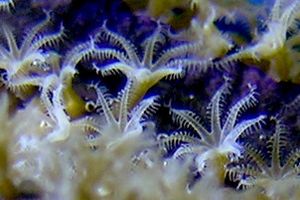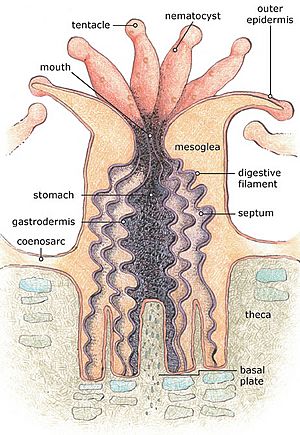Polyp (zoology) facts for kids
A polyp is a small, tube-shaped animal that lives in water. It's one of two main body shapes found in a group of animals called Cnidaria, which includes jellyfish and corals. The other shape is the medusa, which looks like a bell.
Polyps are shaped like a cylinder or a tube. One end of the polyp is usually attached to a surface, like a rock. This part is called the "foot." In a colony, many polyps are connected to each other. The other end has a mouth surrounded by tentacles. These tentacles help the polyp catch food.
Contents
Different Kinds of Polyps
The world of polyps is very diverse! Scientists group them into different classes:
Anthozoa: Always Polyps
In the class Anthozoa, every animal is a polyp. This group includes beautiful sea anemones and corals. They spend their entire lives as polyps, either alone or in large colonies.
Hydrozoa: Polyps and Medusas
The class Hydrozoa is interesting because many species have both a polyp stage and a medusa stage in their life cycle. This means they can look like a tube-shaped polyp at one point and then change into a bell-shaped medusa later on.
Scyphozoa: Jellyfish Life
For Scyphozoa, which are mostly jellyfish, the medusa stage is the most important. The polyp stage might be there or not, depending on the specific family. If there is a polyp stage, it's called a "scyphistoma." This scyphistoma grows and then forms a stack of tiny, plate-like medusae. These medusae then pinch off and swim away. This process is called strobilation. After this, the polyp might die or grow back to repeat the process.
Cubozoa: Box Jellyfish
Cubozoa are a special group. Their tiny larval forms settle down and grow into a polyp. Then, this polyp directly changes into a medusa. It doesn't go through the stacking process like the Scyphozoa.
Polyp Body Parts
A polyp's body is like a simple sac or a bag. Its wall has two main layers of cells. The outer layer is called the ectoderm, and the inner layer is the endoderm.
Between these two layers is a jelly-like substance called mesoglea. This mesoglea helps support the polyp's body. It can be very thin or make up most of the body, especially in larger jellyfish.
Mouth and Tentacles
The polyp's sac-like body is usually attached to something solid at its closed end. At the top, it has a mouth surrounded by a circle of tentacles. These tentacles look a bit like glove fingers.
Tentacles are important for two reasons:
- They help the polyp feel things around it.
- They are used to catch food.
Polyps often extend their tentacles, especially at night. These tentacles have special stinging cells called nematocysts. When a small animal, like a copepod or a fish larva, touches a tentacle, these cells fire. They can pierce, poison, and hold the prey, making it unable to move or killing it.
Movement and Structure
The polyp's body has tiny muscular fibrils. These muscles allow the tentacles to pull food towards the mouth. They also let the whole body shrink or stretch out.
A polyp's body has a main part called the column, which is like its trunk. This column rests on a base or foot. At the top is the crown of tentacles, which surrounds an area called the peristome. The mouth is right in the center of the peristome. Usually, the mouth is the only opening in the polyp's body.
Polyps are very simple animals. They are like "living fossils" because their basic structure hasn't changed much for about half a billion years.
Different Shapes
Polyps come in many different shapes and sizes:
- Some columns are long and thin, while others are very short and flat like a disk.
- They can have hundreds of tentacles, or just one or two.
- Tentacles can be long and thin, or short and bumpy.
- They can be simple or look like feathers.
- The mouth can be flat with the surface or stick out like a trumpet.
Even with all these differences, polyps generally fit into two main types of organization: those in the Hydrozoa class and those in the Anthozoa class. Hydrozoan polyps are often very simple, like the Hydra. Anthozoan polyps, such as corals and sea anemones, are more complex. They have a tube leading from the mouth and special internal walls called mesenteries.
Polyp Reproduction
Polyps have amazing ways to make new polyps. They can reproduce in two main ways: asexually (without a partner) and sexual reproduction (with a partner).
Asexual Reproduction
Most polyps can reproduce by budding. This is like growing a small copy of themselves that eventually breaks off. However, in many cases, these "buds" don't separate from the parent. Instead, they stay connected, forming large colonies. These colonies can become huge and contain many thousands of individual polyps.
The way these buds form can create many different shapes of colonies. For example, the reef-building corals are huge polyp colonies. They create a strong, hard skeleton around themselves.
Sexual Reproduction
Some polyps, like sea anemones, can also reproduce sexually. This means they produce eggs and sperm. Sometimes, a single colony can have both male and female parts. When eggs and sperm combine, they form a zygote. This zygote then develops into a swimming larva.
Most stony corals are hermaphroditic, meaning a single colony has both male and female parts. They usually release their eggs and sperm into the water at the same time during special spawning events. While some can fertilize themselves, they mostly rely on cross-fertilization with other colonies.

Where the Name "Polyp" Comes From
The name "polyp" was given to these animals by a scientist named René Antoine Ferchault de Réaumur. He thought they looked a bit like an octopus. The word "polyp" comes from Greek words meaning "many" and "foot," referring to the octopus's many arms around its mouth.
Threats to Polyps
Sadly, many corals and polyps around the world are in danger. About 75% of the world's corals are threatened by several things:
- overfishing (too much fishing)
- Harmful fishing methods
- Building too much along the coast
- pollution
- High water temperatures (thermal stress)
- ocean acidification (oceans becoming more acidic)
- Predators like the crown-of-thorns starfish
- New species that invade their homes
In recent years, corals and polyps have faced new diseases because their environment is changing. Pollution from farms on land also puts a lot of stress on aquatic life. For example, certain insecticides and fungicides can cause polyps to shrink and their numbers to decrease.
Scientists are also studying how heat stress affects polyps. They've found that high temperatures can cause problems for young polyps. The effects can vary depending on the polyp's age, type, and how far along it is in its growth.
See also
 In Spanish: Pólipo para niños
In Spanish: Pólipo para niños



